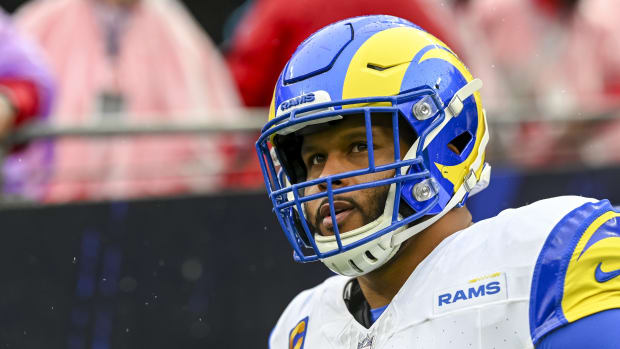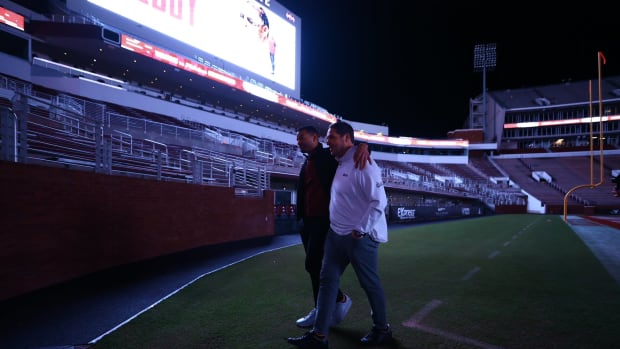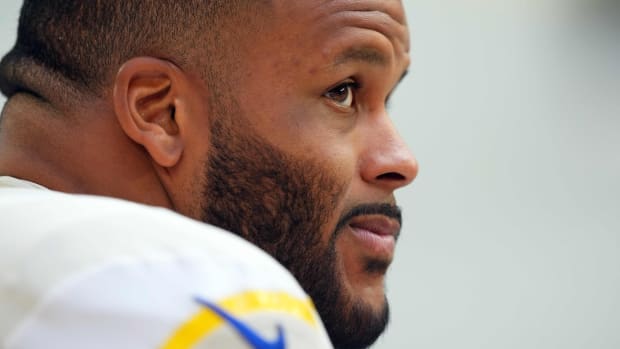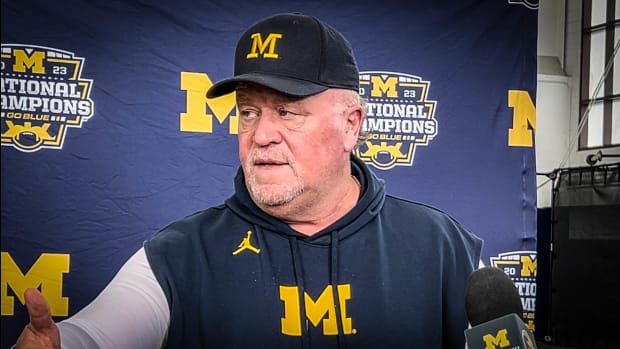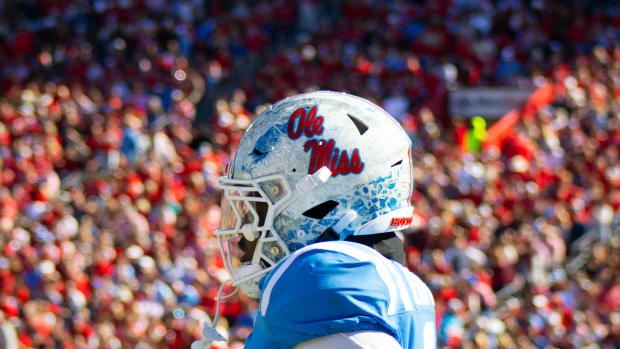Five Teams We Expect to Regress This Season After Strong 2018 Campaigns
Every year, a number of college football teams fall off from the levels of success they reached the season before. The combination of tougher schedules, lost production and coaching turnover often contributes to these drop-offs. Some teams just play worse than they did the season before. After going 13-1 in 2017, Wisconsin fell to 8-5 in 2018 despite bringing back most of its offense and a good chunk of its defense. TCU dropped from 11 wins two years ago to just seven last season.
Which teams will regress next season? Here are five candidates:
Texas (10-4, 7-3 Big 12 in 2018)
The Longhorns are a virtual lock to begin next season in the top 10. Sam Ehlinger enters 2019 as one of the country’s leading Heisman Trophy candidates, and recruiting has been strong for head coach Tom Herman. However, lost production and lurking statistical clues from last season suggest a decline for Texas this season.
For starters, Texas brings back just 48% of its production last season, which is 121st in the country (as calculated by SB Nation’s Bill Connelly). Altogether, the Longhorns will lose eight of their most productive defenders from last season, in addition to leading receiver Lil’Jordan Humphrey, who accounted for over 33% of Texas’s yards through the air in 2018. It’s not as if there aren’t talented players who will get opportunities in increased roles, but that’s still a lot of production to replace. With a September 7 bout with LSU on the schedule, the Longhorns better hope defensive coordinator Todd Orlando’s young defense is ready.
Plus, it wasn’t as if Texas was a juggernaut last season. Despite finish No. 9 in the final AP Poll, the Longhorns ranked No. 43 in the country in point differential, and S&P+ gave them an expected win total of 8.3, down 1.7 from their 10 wins. For as productive as Ehlinger was, Texas lost to Maryland and played close games against Kansas State, Baylor and Kansas, the three lowest-efficiency teams in the Big 12. It was also one of the luckier teams in the country in turnovers, according to Connelly’s adjusted turnover margin metric. The schedule is relatively favorable next season, especially with facing LSU at home, but the numbers points to a possible decline in 2019 for Texas.
Notre Dame (12-1 in 2018)
Ian Book is back at quarterback for Notre Dame, and Julian Okwara and Khalid Kareem will pose as one of the most formidable pass-rushing duos in the country. There are a lot of key losses in South Bend, however, and there are some “regression to the mean” factors at play that could portend a bit of a decline for the Fighting Irish.
Most importantly, a host of key contributors from last season’s team are gone. The departures of linebackers Drue Tranquill and Te’Veon Coney will leave a gaping hole in the middle of the defense, not to mention losing first-rounder Jerry Tillery from the defensive line. Cornerback Julian Love, whose value was underscored when he left last season’s Cotton Bowl against Clemson due to injury, is now on the New York Giants. On the offensive side of the ball, leading rusher Dexter Williams and leading receiver Miles Boykin are also off to the NFL. Even kicker Justin Yoon and punter Tyler Newsome are gone, so the special teams are in flux. Notre Dame has highly recruited players to fill those gaps up and down the roster, but that’s still a lot of production to account for.
Additionally, Notre Dame’s schedule this fall should be more difficult than its 2018 slate. Playing Georgia and Michigan on the road are tall tasks, and USC and Stanford should be better than they were last season. The Irish were perfect in the regular season last year, so it won’t take much for them to “regress” in 2019. Still, there could be a decent-sized drop-off for Brian Kelly & Co. this fall.
Northwestern (9-5, 8-2 Big Ten in 2018)
Coming off a Big Ten West title and its third-straight bowl victory, Northwestern enters 2019 with an excitement-level seldom matched in program history. Former five-star quarterback Hunter Johnson, now eligible and set to start at after sitting out last season, will only amplify the hype for a team that’s being included in nearly every way-too-early Top 25. However, the numbers from last year indicate a fall is likely. Northwestern won nine games in 2018, but its second-order wins, as calculated by SB Nation’s Bill Connelly through S&P+, were just 6.2. This discrepancy was the second largest in the country last season.
The Wildcats’ point differential was also the worst of any Power Five team with nine or more wins last season, and they went 5-2 in one-score games. Pulling out close games has become a long-term trend under head coach Pat Fitzgerald, so there’s probably a little more to that than plain luck. Still, it’s reasonable to expect that record to even out in the future.
With a difficult season-opener against Stanford, road games against Wisconsin and Nebraska and a crossover matchup with Ohio State, Northwestern has a challenging schedule on the horizon. The Wildcats have out-performed their statistical profile for years now, and they don’t lose that much talent from the team that won its division a season ago. But, regression to the mean has to happen at some point, right?
Kentucky (10-3, 5-3 SEC in 2018)
Last season, Kentucky posted its first 10-win season since 1977, though its second-order wins were 7.8, good for one of the bigger discrepancies in the country. With that in mind, the Wildcats’ success could very well be short-lived. First, a lot of the players that powered last season’s team are gone. According to Connelly’s metric, Kentucky ranks No. 114 in the FBS in returning production, and the list of departing names backs that up. On offense, Benny Snell Jr., Kentucky’s all-time leading rusher, is no longer there. On defense, linebacker Josh Allen, cornerback Lonnie Johnson and safety Mike Edwards, who played all over the defense last season, highlight a host of departed difference makers.
Terry Wilson is back at quarterback, but he’s still a question mark after throwing for just 1,889 yards last season in what was more of a game-manager role. Wilson also won’t have five of the Wildcats’ top seven receivers from 2018. Altogether, Kentucky will be young and unproven all over the field next season, which doesn’t bode well for the Wildcats in their road games against Georgia, South Carolina and Mississippi State. Kentucky has a lot to replace this season, and last year’s team probably wasn’t as good as its record showed.
West Virginia (8-4, 6-3 Big 12 in 2018)
West Virginia won’t just be a new team next season; it’ll be a new program after head coach Dana Holgorsen left for Houston this offseason. The Mountaineers, now led by former Troy coach Neal Brown, are No. 105 nationally in returning production, and they’ll lose quarterback Will Grier, who threw for 3,864 yards and 37 touchdowns a year ago. Jack Allison started the bowl game at quarterback when Grier opted to sit out, though he hardly impressed in a shaky 17-of-35 performance against Syracuse. Oklahoma grad transfer Austin Kendall may be the favorite to land the job, but he’s only thrown 39 career passes, so it’s hard to gauge what he’ll be as a starter.
Grier’s top two receivers, David Sills V and Gary Jennings Jr., are also off to the NFL, and dual-threat tight end Trevon Wesco departs, too. There isn’t quite as much turnover on defense, but leading tackler David Long Jr., widely considered the engine in the middle of WVU’s defense, exhausted his eligibility.
In 2019, games against Missouri and NC State early in the season won’t be easy, and road games at Oklahoma and Baylor in back-to-back weeks could spell trouble later on. There are unknowns all over the field as West Virginia transitions into a new era.





